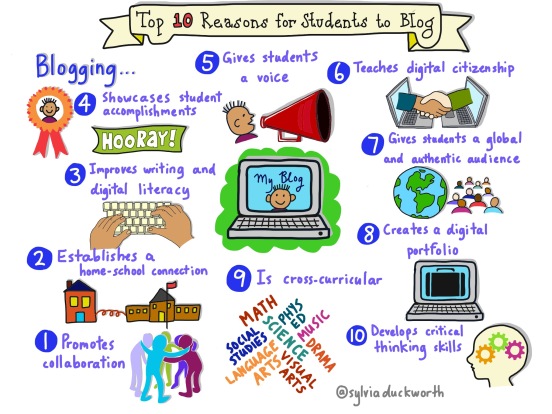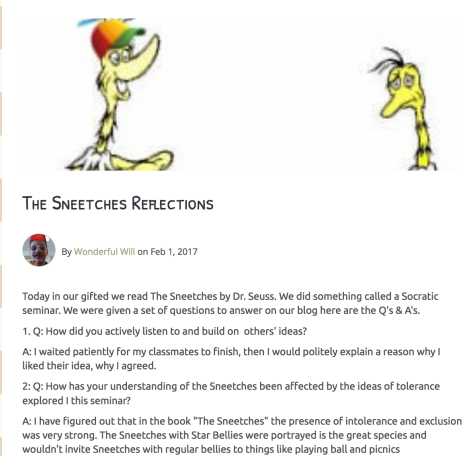Documenting and Reflecting on Learning
I am a strong proponent of encouraging learners of all ages to engage in reflective practice.
Learners do not just receive information only at the time it is given; they absorb information in many different ways, often after the fact, through reflection. The most powerful learning often happens when students self-monitor, or reflect. Students may not always be aware of what they are learning and experiencing. Teachers must raise students’ consciousness about underlying concepts and about their own reactions to these concepts. ETE Team
Documenting Learning
Silvia Tolisano sees documenting learning as:
-
a process of intentional documenting serves a metacognitive purpose
- a creative multimedia expression (oral, visual, textual)
- a component of reflective practice
- taking ownership of one’s learning
- a memory aid
- curation
- being open for feedback (Documenting FOR Learning)

Blogging as a Form of Documenting Learning and Reflection
I find blogging to be a one of the most powerful ways to documenting learning and engage in reflective practice.
Blogging has its own unique benefits as Sylvia Duckworth’s Sketchnote summarizes:

Experiential, STEM, STEAM, and maker education are the focus of my gifted education classes. The learners in my gifted education classes have access to Chromebooks. Having learners take pictures of their artifacts and describing what they did is a standard practice in my classes.
Sometimes I list vocabulary words I ask learners to include in their blogs. For example, for a design challenge, I asked learners to include the following vocabulary:
- design thinking
- communicate
- empathy
- tolerance
Here are some example blog posts from 6th grade students:



Blogging, as opposed to keeping a hand-written journal of classroom experiences, has unique advantages in my classroom:
- Learners can easily include photos of their work.
- Work is easily reviewed and edited for errors.
- Learners’ classmates can easily view and comment on one another’s work.
- Blogging acts as a formative assessment whereby I, as the educator, get an opportunity to learn what elements of the projects were significant for my learners.
A Picture Tells So Many Stories
Because my classroom activities are high engagement, learners become totally immersed in the activities. They aren’t interested in taking photos during the activities. Also due to the student-centric nature of the learning activities, my role becomes that of facilitator walking through the classroom and visiting with individual groups of students to find out what they are doing, answer questions, give feedback. This guide-on-the-side role allows me to take lots of photos of the students. In essence, then, I become the official photography documenting student learner so they and their parents have an archive of the school year’s activity. We review these photos throughout the school year as a form of reflection. It’s fun to hear the learner comments exclaiming joy and amazement in what they learned earlier in the school year.
Here are links to photos I took for my two gifted classes and posted to a shared folder on Google Photos during the 2016-17 school year:
A Final Reflection
As a way to wrap-up the school year, learners should be given the opportunity to review their work from the past school year. For my learners, I asked them to look through all of the photos I took and the blog posts they wrote and choose between 5 and 10 of their most favorite and best projects. (It was great listening them express their delight in reviewing all of the projects they completed during the school year.) After selecting these, learners were asked to create a presentation of their chosen works using one of the following options:
They then presented their work to their peers and a group of adults: parents, school officials, visitors to the school.
A few afterthoughts about this final activity:
- Throughout the school year, learners were asked to present their learning in front audiences. One of the students has a dual diagnosis – gifted and Asperger’s. This student wouldn’t even talk to the group at the beginning of the year. Loved the confidence shown during the final presentation.
- The final presentations gave me, as the educator, a type of program evaluation where I got the opportunity to learn the most significant classroom projects from my learners’ perspectives.

Dear Jackie,
Hello from Sydney, Australia. I am a Head of Department for Grades 7-12 covering Mandatory Technology Y7-8, Design and Technology, Textiles and Design, Information Systems Technology and Information Processing Technologies and IB Computer Science in Grades 10-12. We have strong links to our Grade 6âs and support their teachers to give engaging and curiosity based learning experiences in a range of technologies.
I love reading your blogs and the fact that they are so rich with activities, software and reflections from you and your students.
Earlier this year you posted a blog on story writing, story boarding moving into game design which I would like to use as a model to build on with my Grade 8âs incorporating green screening and moving into VR possibly unity etc.
Could you please send me this newsletter-content again as I want to get my team onto writing a program for this and need the software links etc.
Regards
Alannah Nastase Coordinator Innovative Design, teacher
[cid:image001.jpg@01D2D2DC.5FBC9C00]
272 Military Rd, Cremorne NSW 2090
T: 61 2 9968 9825 F: 02 9909 3228
E: anastase@redlands.nsw.edu.au W: http://www.redlands.nsw.edu.au
From: User Generated Education
Reply-To: User Generated Education
Date: Monday, 22 May 2017 at 3:42 am
To: Alannah Nastase
Subject: [New post] Documenting and Reflecting on Learning
Jackie Gerstein, Ed.D. posted: “I am a strong proponent of encouraging learners of all ages to engage in reflective practice. Learners do not just receive information only at the time it is given; they absorb information in many different ways, often after the fact, through reflection. “
Alannah Nastase
May 21, 2017 at 11:18 pm
Thank Alannah – do you mean Video Game Design with Elementary Learners https://usergeneratededucation.wordpress.com/2017/05/05/video-game-design-with-elementary-learners/
Jackie Gerstein, Ed.D.
May 22, 2017 at 2:28 am
Love this post, especially as I moved to competency based and personalized learning models. Big moves, but using your blog extensively to help me plan. Reflection is a huge piece of the ownership puzzle. Detail question for you. You mentioned you students using chromebooks to document learning using pictures and blogging. Can you give me some logistical details on that, we use chromebooks too and still figuring out all they are capable of, do they have a camera built in or are kids using their own devices?
Carlyn Nichols (@SciSamurai)
May 26, 2017 at 6:26 pm
Thanks, Carlyn – the Chromebooks my students use have everything to document learning – they do have cameras – see https://support.hp.com/rs-en/document/c03654623
Jackie Gerstein, Ed.D.
May 28, 2017 at 1:32 pm
I like your thinking but I wholeheartedly believe that ALL students benefit from this type of teaching and learning, not just “gifted” kids. I was a “Gifted and Talented” specialist in my school system for years. It was very exclusionary, and did not support what we know and believe to be the truth about growth mindset. Our system changed the program to “Enrichment and Challenge”, and now we reach all kids. We set a high bar, and it is amazing at the how high the level of thinking is if the expectations and support (and differentiation) is there to help students reach it.
Tanya
May 29, 2017 at 8:58 pm
I agree – good teaching should be good teaching for all students. I do teach gifted and talented but in two Title 1 schools where we work hard to get typically under-identified students into the program. But even though this post focuses on my students, I believe in the importance of ALL students engaging in enriched activities; and documenting/reflecting on their learning.
Jackie Gerstein, Ed.D.
May 29, 2017 at 9:22 pm